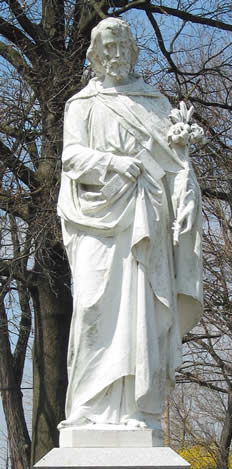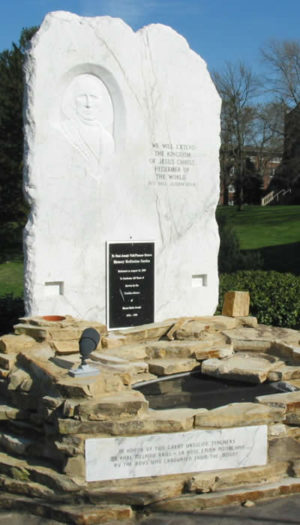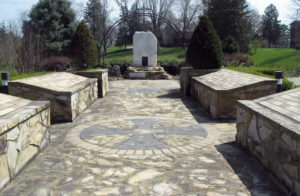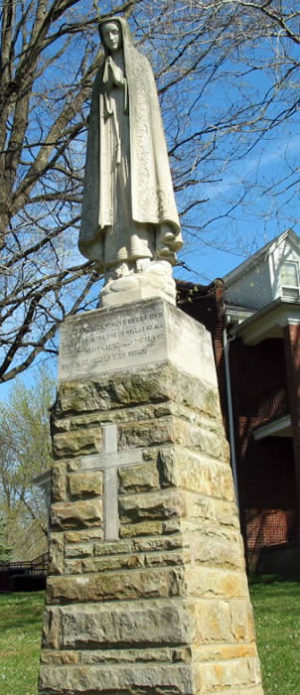A Visit to the Shrines
Come to Maple Mount and take part in the Shrine Meditation Walk on the grounds of the Motherhouse for the Ursuline Sisters of Mount Saint Joseph. No appointment is necessary, just come share in the beauty at the Mount.
Listen to the audio of the Shrine Meditation Walk
Christ the King
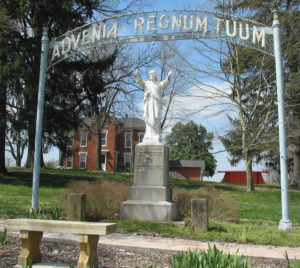
Feast Day: Last Sunday of the Liturgical Year
This is a medieval feast, using the metaphor “King” for describing Christ. Today, the implications of such a metaphor are harder to understand. Though there remains a fascination for royalty and royal families, most cultures have moved toward a more participatory form of governance. The kingdom that Jesus preached was the Kingdom of his Father: a kingdom of forgiving love with no royal trappings. The scepter of this kingdom is righteousness, justice, abundant peace, and love. Christ is King in hope and faith that Jesus hasn’t gone away.
Saint Joseph
Northwest Corner of the Campus
Feast Day: March 19th
Saint Joseph, husband of Mary, foster father of Jesus, was an honorable man who trusted the mysterious ways of God; heeded the voice of an angel and went into exile to protect Mary and the Baby; provided his family security through his daily labors as a carpenter and stone cutter. He is the special guardian of the universal Church, and the Ursuline Sisters of Mount Saint Joseph; the patron of married couples, carpenters, bursars, house hunters and seller, doubters, housewives, the dying.
Father Paul Joseph Volk: 1841-1919
Northwest Corner of the Campus
Missionary priest to North and Central America Father Volk came from Fulda, Germany to Louisville, Kentucky in 1869, became pastor of Saint Alphonsus in 1870, and built Mount Saint Joseph Academy in 1874. He was a tireless missionary: built a total of 27 churches in Central America and Kentucky; worked, incognito, as a common laborer in the building of the Panama Canal to finance the construction of churches in Panama. Resulting from his deep faith and devotion to Saint Joseph, he is credited with three local miracles: a) hardening of clay for the bricks used in the original Academy building (still-standing); b) safely crossing the dangerously flooded Green River on horseback, without even getting wet feet, to attend a dying person in Reed; c) curing a severely crippled young man in Beech Grove.
The Five Pioneer Ursuline Sisters
Northwest Corner of the Campus
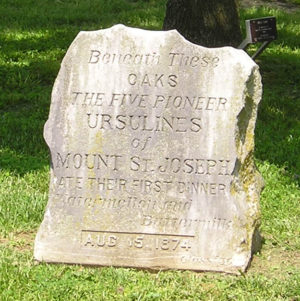
The Memorial Meditation Garden 
Northwest Corner of the Campus
Deep within the human heart is the desire to immortalize heroes and heroines. The circle of names enclosing this garden attempts to express that longing to celebrate those special persons who gave us life and nurtured our dreams.
Saint Agnes: 291-303
Center Campus East
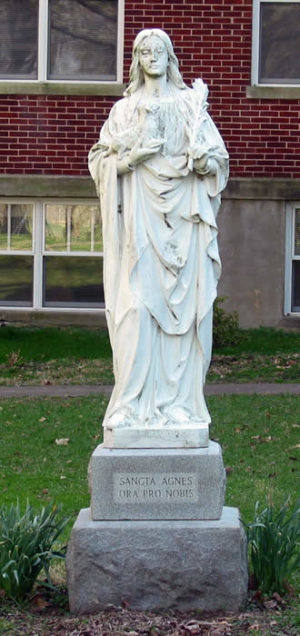
Agnes, the daughter of a noble Roman family, became a Christian and was martyred at the age of 12. Her persecutors tried to force her into prostitution. When their attempt to burn her naked body failed, they decapitated her. She is depicted holding a lamb and a palm branch. Since the 9th century, on the feast of Saint Agnes, two lambs are slaughtered at the Church of Saint Agnese, San’t fuori le Mura, France. From the wool of these lambs is made the pallium (a strip of white wool with black crosses woven into the fabric) given by the Pope to an archbishop as a sign of his office.
Our Lady of Fatima
Center Campus East
Feast Day: May 13th
Throughout the Old Testament, God chose prophets to call His people back to Him. In recent times, God is sending His Mother. One of the apparitions of Mary in the 20th century took place at Fatima, Portugal. She appeared to three shepherd children, Lucia, Francisco and Jacinta in 1917. Our Lady’s message warned of the harm that we inflict upon ourselves because of greed and lust for power, lack of love among nations, and rejection of the Gospel. Her plan of hope for the world called for daily devotion would bring about the conversion of Russia, the end of World War I and peaceful reconciliation among nations.
Saint Theresa of Lisieux: 1873-1897
Center Campus East
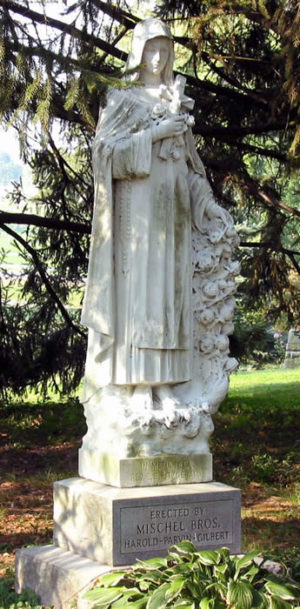
Patron of the Missions Many Catholics have admired this young saint known as Saint Theresa, the Little Flower. She was born in France in 1873, entered the cloistered Carmelite monastery at age 15, and died when she was 24. Martyrdom was the dream of her youth. She also felt called to be a priest. She arrived at peace by accepting that “my vocation is love.” Her secret is called The Little Way: no act is without meaning when done within the awareness of God’s abiding presence. Soon after her death, public demand was so great that this young woman, who had spent only 9 years as a Carmelite nun doing dishes, laundry, scrubbing floors, cleaning, praying for the missions purely out of love, was canonized and named a Mystical Doctor of the Church. The national shrine of the Little Flower is in Detroit, Michigan.
Saint Anthony of Padua: 1195-1231
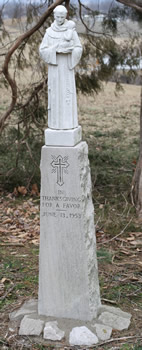
Feast Day: June 13th
Anthony became a Franciscan friar in the hope of shedding his blood for Christ. In France and Italy, he was the most renowned preacher of his day. Upon exhumation, some 336 years after his death, his body was found corrupted, but his tongue was totally uncorrupt, so perfect were the teachings that had been formed upon it. Saint Anthony is known to have moved with ease in the realm of minor and major miracles: raising the dead, exorcising the devil, and having a special power of restoring lost things. Saint Anthony is usually depicted holding the Infant Jesus, who on one occasion, miraculously appeared to him and rested in his arms. Sometimes the Infant is shown holding keys and glasses that Anthony is looking for.
Saint Jude Thaddeus, Apostle
Center Campus East
Feast Day: October 26th
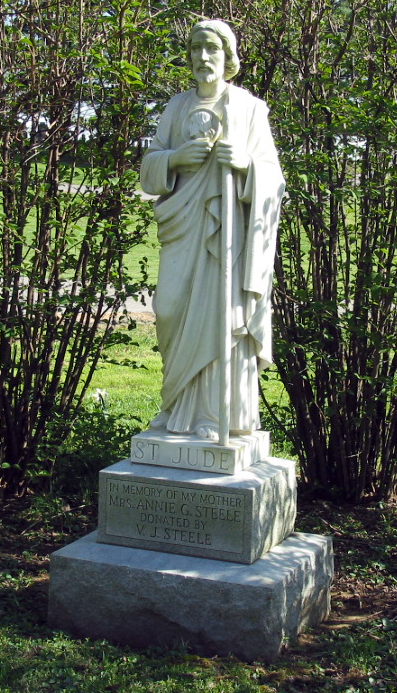
Our Lady of Prompt Succor
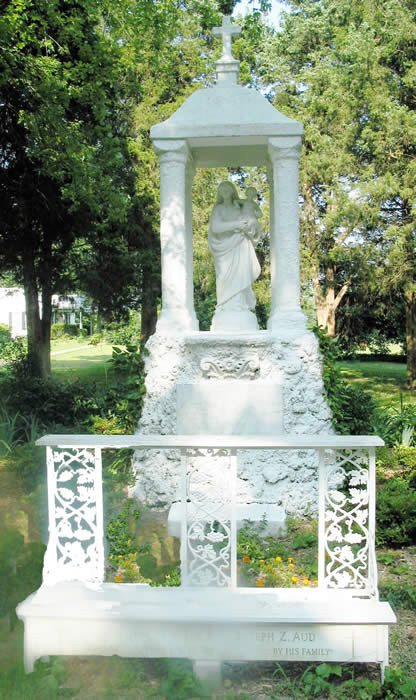
Feast Day: January 15th
Devotion to Our Lady of Prompt Succor, (Our Lady of Quick Help), was planted in this country by the Ursulines who came from France to New Orleans in 1727. It remains characteristically an Ursuline legacy. The recognition of Our Lady as patron of the state of Louisiana is supported by the miracles that, on two separate occasions, saved the city of New Orleans from peril: the victory of the Americans over the British in the Battle of New Orleans during the War of 1812, and escape from the catastrophic fire of 1815. In each of these dangers, the Ursulines were asked to pray for a safe deliverance. Both times, Our Lady of Prompt Succor came to the rescue: America was saved from British rule; wind changed course and the fire out to sea. New Orleans boasts of the national shrine of Our Lady of Prompt Succor. Our Lady of Prompt Succor shrine here at Maple Mount was built to fulfill a promise made by two Ursulines of Mount Saint Joseph who were on a cruise in the Caribbean with relatives when a hurricane threatened the destruction of everything in its path. The sisters asked Our Lady of Prompt Succor to spare their ship, and the lives of its passengers and crew. Their ship was among the few that safely reached shore.
The Cemetery
The Crucifix
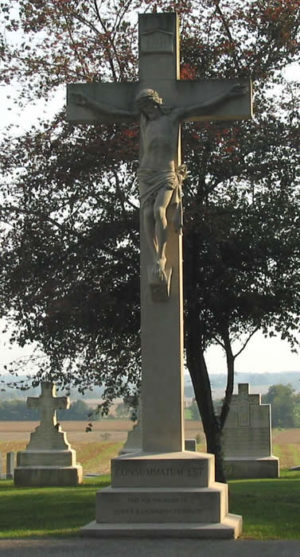
The Cemetery

